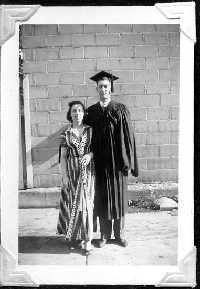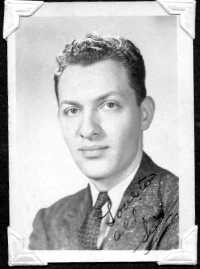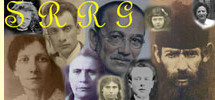March 5th and 6th of 1938, Helen was a delegate at a Regional Conference of Jr. Hadassah held at the Deshler-Wallick Hotel, in Columbus, Ohio. For this occasion, Adolph created a gorgeous ankle- length evening coat for a dinner dance she would attend. It was royal blue velvet, lined in white satin (museum quality). I wore it to several dances when I was in high school (I was 13 years younger) For me, this coat-gown was a symbol of my father's talent that the Depression could not belie.
Sid graduated Toledo University and applied to the medical school and to about three other schools. Phil recalls the difficulty our parents had finding money for these applications. As a result, the forms were sent in late. In the meantime, Sid had been working part time for the doctor who was chairman of the pre-med department. His job consisted of cleaning the doctor's office; Sid thought a good friendship and relationship had developed between them.
|
|

|
The medical school's unofficial policy was to admit only one Jew. Sid and his best friend were both candidates. Receiving a full scholarship was essential for Sid to attend. His friend's parents, however, were able to pay the tuition. One day (Phil tells me) when Sid cleaned out the doctor's wastebasket, he found a letter written by him about Sid. In it the doctor said: "make no mistake, he (meaning Sid) was Jewish".
This revelation and the fact that Sid needed a scholarship was probably the reason the school declined to accept him. Phil said the whole family, including Sid of course, was affected by the outcome. Everyone was rooting for Sid, as they would an athlete or team. He was the first of the boys to step into the big world. It would have given the family such a needed emotional boost of pride, having a brother and son in medical school, let alone, a sense of "hope" for my older brothers who would soon follow in Sid's footsteps. Most devastating to Sid was finding out his friend, the doctor, was really not his friend at all.
Sid bounced back, however, and applied to Ohio State for a masters degree in chemistry. Tired of working so hard to pay for board and room (received a scholarship in academics) he decided to graduate in one year. As mentioned before, Sid achieved this incredible goal, receiving 2 As.
|
|

|

|
|
In 1939, there was little call for chemists-jobs were hard to find. One company, the Ethyl Corporation of Baton Rouge, Louisiana (producers of tetra -ethyl lead-a lead compound additive to gasoline) offered Sid a job. He jumped at the opportunity and for the first time, one of Lena and Adolph's children left home. It was a bittersweet moment to be sure. Our parents loved Sidney very much, he being their first born and what a child he was. His good nature and talents eventually brought them the pleasure and personal pride that life had denied them at this time.
There was almost a finality in saying goodbye. No cell phone or e-mail. Communication for the most part consisted of writing long-hand letters. Long-distance phone calls were prohibitive because of the cost as was traveling by bus or train which was also time consuming. Flying was out of the question. At best, Sid would not be expected to visit the family for some time to come. Occasionally, though, the company sent him to Detroit, Michigan, (about a 3-hour drive to Toledo) at which time he would rent a car and stay a day or two.
|
In 1938, Lena, unable to cope with Chana, sent her to uncle Julius in Cincinnati, Ohio. He placed his mother in the Jewish Home for the elderly. After 1 ½ years, my grandmother died May of 1939, about age 89, and was buried in Toledo, Ohio next to Fischel.
Chana's death certificate, signed by Lena Reiter, Julius' wife, is void of any personal information, not even to note that she had been a midwife. Bobbie died of arterialsclorosis (hardening of the arteries).
Jeanne
I was six years old, starting Fulton school kindergarten in February of 1938. Frankie and I had gone to Warren school the first semester, but our mother, Lena, didn't think it was a good enough school or neighborhood. It was on the other side of Bancroft street close to the Putnam house and now we had to walk a long distance to the new school. But it was worth it, as Fulton school at that time was the elite school and district and new classmates became our friends we grew up with throughout our school years including high school.
I was able to sing at this age-a high, thin voice but lyrical, I imagine. My kindergarten teacher was Miss Irene Shannon who was a soprano, having graduated from the Collingwood Avenue convent. She took an interest in me and in the Spring of this year she bought me a beautiful pink party dress (it was supposed to be a secret, but of course I told everyone) to wear when I sang two solo songs at the 8th grade Gleeclub concert in May.
This is when my life "brightened up"-music became an important part of it. From that time on I became a soloist at school including singing for the class when the teacher had to leave the room for some reason. Lena took me to a neighborhood Conservatory for voice lessons, but she was told I was too young and that it would be best that I study piano. I began but apparently didn't like practicing scales so it was two more years before I continued lessons. From then on, I and the piano were together all through my school years. In the meantime I continued to sing but not train the voice and that was the biggest mistake. I didn't realize what a loss that would ultimately be for the voice and me. There was no money for both lessons and I was happy studying the piano and just singing which came so natural.
1938 Holocaust refugees turned back to Europe from Palestine
"The British government after 1937-38 started limiting Jewish immigration into Palestine. In April 1939 the White Paper was issued limiting Jewish immigration to 75,000 during the next five years. Around that time three small ships arriving in Haifa were forced back out to sea.
The Romanian steamer Sandu with 269 people on board was arrested on March 23rd and sent back.
On April 1st, the Astir with 724 people was brought into Haifa. Among these were 200 members of Betar. Forced to leave, the ship wandered the Mediterranean for some 16 weeks, short of provisions.
On March 31st, the Aghios Nicolaos was fired on by a British patrol boat and one refugee was killed. She had sailed from Constanta. Her passengers later landed secretly on the beach.
Worse, on April 11th the Assimi with 369 passengers arrived. The people were detained on board while the captain was tried in court, and then the ship was forced to leave on the 23rd. She was unseaworthy and in urgent need of provisions and water. On July 7th, her passengers were seized while trying to land at Nahariya.
All the people on these ships eventually made their way to Palestine within a few months. All later arrivals were taken into Haifa and the passengers interned at Sarafand or Athlit camps until the quota opened up and they were released.
These were the only instances of people being turned away by the Palestine authorities. Some other groups and ships never made it to Palestine. In one large group detained at Kladovo in Yugoslavia, and 915 were killed by the Nazis after the German invasion in 1941.
Of the group deported to Mauritius in 1940, all were returned to Palestine in 1945.
Complete information may be found in my booklet "Our Only Refuge, Open the Gates!"(14)
|
February 19th, First Congregation Sick Aid Society
Kudryncer annual affair
"Dear Brothers, Sisters, and Friends:
the Jewish masses of Poland are today faced with expulsion. Every JEW in Poland, no matter where he resides, is in danger of losing his life. Kudryncer JEWS, your friends and relatives are in dire troubles, we cannot ignore the call of our brethren on the other side. We must come to their rescue".
In order to make definite plans to aid our co-religionists on the other side, we are calling a special mass meeting of all our members and friends Kudryncer, on Saturday evening, February 19, 1938, 8:30 pm.
Fraternally yours,
Victor Augenstein, President.
Chas. Wexelblatt, Vice President. , Max Jaffe, Sec'y
Isak Hollenberg, Recording Sec'y
Max Hollenberg , Isadore Malamut , Mattes Reinstein
Chairlady of Kudryncer Ladies' Auxiliary , Duvra Grossman
Max B. Lindenbaum
|
Stanford entered Ohio State University this year. His hope was to become an electrical engineer. He was still a naval reservist.
|




